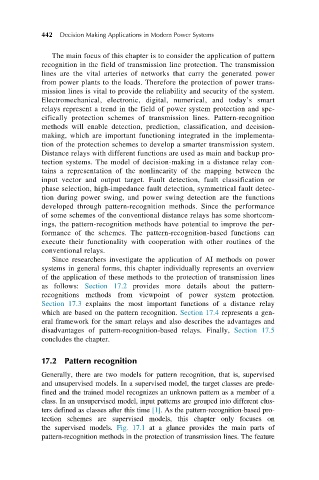Page 482 - Decision Making Applications in Modern Power Systems
P. 482
442 Decision Making Applications in Modern Power Systems
The main focus of this chapter is to consider the application of pattern
recognition in the field of transmission line protection. The transmission
lines are the vital arteries of networks that carry the generated power
from power plants to the loads. Therefore the protection of power trans-
mission lines is vital to provide the reliability and security of the system.
Electromechanical, electronic, digital, numerical, and today’s smart
relays represent a trend in the field of power system protection and spe-
cifically protection schemes of transmission lines. Pattern-recognition
methods will enable detection, prediction, classification, and decision-
making, which are important functioning integrated in the implementa-
tion of the protection schemes to develop a smarter transmission system.
Distance relays with different functions are used as main and backup pro-
tection systems. The model of decision-making in a distance relay con-
tains a representation of the nonlinearity of the mapping between the
input vector and output target. Fault detection, fault classification or
phase selection, high-impedance fault detection, symmetrical fault detec-
tion during power swing, and power swing detection are the functions
developed through pattern-recognition methods. Since the performance
of some schemes of the conventional distance relays has some shortcom-
ings, the pattern-recognition methods have potential to improve the per-
formance of the schemes. The pattern-recognition-based functions can
execute their functionality with cooperation with other routines of the
conventional relays.
Since researchers investigate the application of AI methods on power
systems in general forms, this chapter individually represents an overview
of the application of these methods to the protection of transmission lines
as follows: Section 17.2 provides more details about the pattern-
recognitions methods from viewpoint of power system protection.
Section 17.3 explains the most important functions of a distance relay
which are based on the pattern recognition. Section 17.4 represents a gen-
eral framework for the smart relays and also describes the advantages and
disadvantages of pattern-recognition-based relays. Finally, Section 17.5
concludes the chapter.
17.2 Pattern recognition
Generally, there are two models for pattern recognition, that is, supervised
and unsupervised models. In a supervised model, the target classes are prede-
fined and the trained model recognizes an unknown pattern as a member of a
class. In an unsupervised model, input patterns are grouped into different clus-
ters defined as classes after this time [1]. As the pattern-recognition-based pro-
tection schemes are supervised models, this chapter only focuses on
the supervised models. Fig. 17.1 at a glance provides the main parts of
pattern-recognition methods in the protection of transmission lines. The feature

